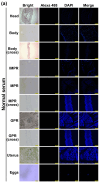Molecular Characteristics of the Malate Dehydrogenase (MDH) Gene Family in Spirometra mansoni (Cestoda: Diphyllobothriidea)
- PMID: 39201488
- PMCID: PMC11354392
- DOI: 10.3390/ijms25168802
Molecular Characteristics of the Malate Dehydrogenase (MDH) Gene Family in Spirometra mansoni (Cestoda: Diphyllobothriidea)
Abstract
The plerocercoid larva of Spirometra mansoni can cause a parasitic zoonosis-sparganosis. Malate dehydrogenase (MDH) plays a very important role in the life activities of parasites. However, little is known about the MDH family in S. mansoni. We identified eight new MDH members in S. mansoni in this study. Clustering analysis divided SmMDHs into two groups and revealed patterns similar to the conserved motif organization. RT-qPCR suggested that five MDHs were highly expressed in the mature proglottid and that three MDHs were highly expressed in the gravid proglottid. Phylogenetic analysis revealed that SmMDHs contain both conserved family members and members in the process of further diversification. rSmMDH has an NAD binding domain, a dimer interface and a substrate binding domain. Natural SmMDH was immunolocalized in the tissues and follicles around the uterus in the mature or gravid proglottid and eggshells. The maximum forward and reverse reaction activities of rSmMDH were observed at pH 8.5 and 9.0, respectively. The optimum temperature for enzyme activity was 37 °C in the forward reaction and 40 °C in the reverse reaction. These results lay the foundation for studying the molecular functions and mechanisms of MDHs in S. mansoni and related taxa.
Keywords: Spirometra mansoni; gene expression; malate dehydrogenase; molecular characterization; tapeworm.
Conflict of interest statement
The authors declare no conflict of interest.
Figures









Similar articles
-
Lactate Dehydrogenase Gene Family in Spirometra mansoni (Cestoda: Diphyllobothriidea)-Phylogenetic Patterns and Molecular Characteristics.Animals (Basel). 2023 Nov 24;13(23):3642. doi: 10.3390/ani13233642. Animals (Basel). 2023. PMID: 38066993 Free PMC article.
-
Annexin gene family in Spirometra mansoni (Cestoda: Diphyllobothriidae) and its phylogenetic pattern among Platyhelminthes of medical interest.Parasite. 2024;31:32. doi: 10.1051/parasite/2024034. Epub 2024 Jun 21. Parasite. 2024. PMID: 38912916 Free PMC article.
-
Molecular Characteristics of the Fatty-Acid-Binding Protein (FABP) Family in Spirometra mansoni-A Neglected Medical Tapeworm.Animals (Basel). 2023 Sep 8;13(18):2855. doi: 10.3390/ani13182855. Animals (Basel). 2023. PMID: 37760255 Free PMC article.
-
Malate valves: old shuttles with new perspectives.Plant Biol (Stuttg). 2019 Jan;21 Suppl 1(Suppl Suppl 1):21-30. doi: 10.1111/plb.12869. Epub 2018 Jul 17. Plant Biol (Stuttg). 2019. PMID: 29933514 Free PMC article. Review.
-
Prevalence of Spirometra mansoni in dogs, cats, and frogs and its medical relevance in Guangzhou, China.Int J Infect Dis. 2016 Dec;53:41-45. doi: 10.1016/j.ijid.2016.10.013. Epub 2016 Oct 21. Int J Infect Dis. 2016. PMID: 27777093 Review.
References
-
- Wang R.J., Li W., Liu S.N., Wang S.Y., Jiang P., Wang Z.Q., Zhang X. Integrated transcriptomic and proteomic analyses of plerocercoid and adult Spirometra mansoni reveal potential important pathways in the development of the medical tapeworm. Parasit Vectors. 2023;16:316. doi: 10.1186/s13071-023-05941-8. - DOI - PMC - PubMed
-
- Musrati R.A., Kollárová M., Mernik N., Mikulásová D. Malate dehydrogenase: Distribution, function and properties. Gen. Physiol. Biophys. 1998;17:193–210. - PubMed
MeSH terms
Substances
Grants and funding
LinkOut - more resources
Full Text Sources

